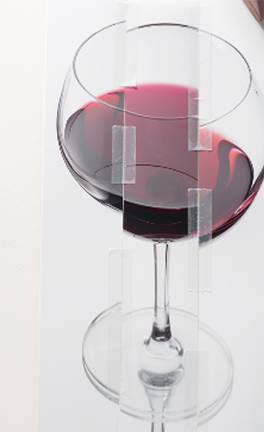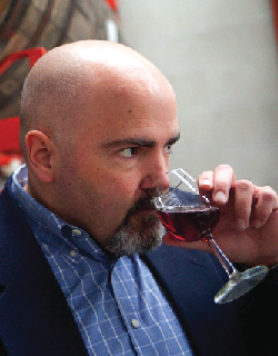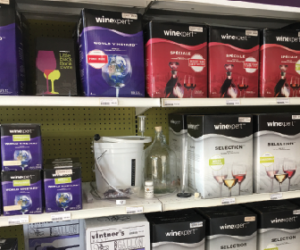 Blending accomplishes several goals in winemaking. It can be done to improve flavor, mouthfeel, cover a defect, balance the chemical profile, adjust the alcohol content, emulate a commercial wine you enjoy or simply for product consistency. Blending is both a science and an art. The correct blend to adjust the alcohol content of a wine can be calculated. However, pH and acidity adjustments are not as straightforward due to the buffering capacities of the blend components, and the real judge of that blending process is your palate.
Blending accomplishes several goals in winemaking. It can be done to improve flavor, mouthfeel, cover a defect, balance the chemical profile, adjust the alcohol content, emulate a commercial wine you enjoy or simply for product consistency. Blending is both a science and an art. The correct blend to adjust the alcohol content of a wine can be calculated. However, pH and acidity adjustments are not as straightforward due to the buffering capacities of the blend components, and the real judge of that blending process is your palate.
As you may well know, many of the world’s greatest wines are blends of varieties from the regions where they are grown; Provence has its blends based around Grenache, Syrah, Mourvèdre and Cinsault. Bordeaux is based around Cabernet Sauvignon, Merlot, Petit Verdot, Malbec and Cabernet Franc. In Burgundy, where Pinot Noir is the major red grape grown, blends are produced from different vineyards or wines produced from the same vineyard, yet produced by multiple winemakers who own a small section of the vineyard. Tuscan blends are based around Sangiovese, and then in response to build a wine that could compete on the world market, some of the winemakers of Tuscany went against the Denominazione di origine controllata, (DOC) governing rules, and developed the “Super Tuscans” with the incorporation of Cabernet Sauvignon, Merlot, other Bordeaux varietals and Syrah. In these regions, this was the result of having made wines for many years with the same varieties and knowing what blends together the best. Truth be told, not every wine is perfect, and blending works as a tool to make something drinkable that is desired by the consuming public. For larger wine producers, the concept of blending is one that produces a consistent product from year to year to gain consumer acceptance and confidence that every bottle of that brand they open will taste just like the last one.
If you are new to blending, the charts below list twenty of the most common grape varieties and their most common major and minor blending partners. Rather than list every possible blending partner, the charts show the varieties winemakers have had the most success with in the past. Another starting point for beginners is, of course, to think back to commercial wines you have enjoyed. Let these suggestions be your guide, but don’t let them dissuade you from trying something completely different, if you think it might work. Let your palate be the judge. Your perfect blend may be one bench trial away.
You must realize the first principle of blending is that there is really no way to make a mediocre or poor wine better by blending it with another wine of the same quality. Therefore, this first principle then requires the use of good to exceptional wines to make the wine of the lower quality wine better. This sounds sacrilegious to some, but it is a commonly held practice in the industry. From a business standpoint, the goal is to make every wine sellable and this can be challenged in a year in which fruit quality is compromised. Despite the variability of vineyards and winemakers, there are good to exceptional wines produced every year, and some of these wines are used to make the challenged wines better. To do this, first identify the attribute, or attributes that you are looking to correct. This takes a careful sensory examination of the wine, examining color, tannins, acidity, pH, volatile acidity and alcohol.
Alcohol is probably the easiest blending challenge as blend proportions can be calculated. A given volume of wine at 12.5% alcohol by volume (ABV), when blended with the same volume of wine at 13.5% ABV, will yield twice the volume of wine at 13.0% ABV. For less obvious blends, the calculations are made easy by using the Pearson’s square method.
To understand how the Pearson’s square works, we work with the simple example listed previously. First, draw a square, and write the higher alcohol wine in the upper left corner, and the lower alcohol wine in the lower left corner.
Wine A 13.5%Volume A (X gallons)
Wine B 12.5%Volume B (X gallons)
You have equal parts of each wine. As we know the final alcohol concentration, we list that in the middle of the square. To calculate the blend alcohol, simply take the absolute values of the differences of the middle figure and the corner figures and write them in diagonally from the blended wines:
13.5-13.0 = 0.5
13.0-12.5 = 0.5
In other words, the blend is half (0.5) Wine A and half (0.5) wine B.
So how does the Pearson’s square example help us? When blending for alcohol balance, some winemakers think they can target the “sweet spot” for alcohol levels. The general consensus is that this lies somewhere between 13.0% ABV and 14.0% ABV, which is subject to debate by those who think it should be lower or higher.
The next example is one where you want to target the final alcohol concentration of a blend at 13.8% ABV, where you have 10 gallons of Wine A at 16.0% ABV and 15 gallons of Wine B at 12.0% ABV.
Wine A 16%Volume A (X gallons)
Wine B 12%Volume B (Y gallons)
To calculate the final blend ratio, simply take the absolute values of the differences of the middle figure and the corner figures and write them in diagonally from the blended wines:
16.0-13.8 = |-2.2| = 2.2
13.8-12.0 = 1.8
Add the blend ratios together:
2.2 + 1.8 = 4.0
Determine the proportion of each wine:
Wine A 2.2/4.0 = 0.55 (or 55%)
Wine B 1.8/4.0 = 0.45 (or 45%)
In this example, you would then choose a final volume of wine and determine the volume of each component in the blend by multiplying the total volume by the proportion of each component. For example, if you decided to make 15 gallons of the blend, you would calculate the amount of Wine A by multiplying 15 times 0.55 (the proportion of A in the blend), which yields 8.25 gallons. The volume of Wine B would be 6.75 gallons. As a final check, these volumes should sum to your total blend volume, as is the case here (8.25 + 6.75 = 15).
Winemakers almost never have to adjust the alcohol only. Poor color development, tannin balance and acidity are other major considerations in most blends. Color is the second simplest concept in blending to understand; blend darker pigmented wines into lighter reds to increase their color depth. The best examples of this are those mentioned previously in Provence or Tuscany; Syrah, Cinsault and Mourvèdre improving the lighter colored Grenache and the Cabernet Sauvignon or Merlot improving the looks of the Sangiovese. Keep in mind that color intensity will not necessarily be additive after the blend has aged for awhile.
Acidity and pH affects mouthfeel and bitterness in wines. Too high acidity leads to sour wines, too low and they have no structure. Add as much tannin to them as you wish, a wine with low acidity is just flabby and unremarkable in the mouth. When blending to add acid structure, you are looking for something crisp on the palate, but not bitter.
Tannin chemistry in wine is a very complex subject. In blending, the most practical approach, on a small scale, is how the individual wines present themselves to your palate. Are they thin and watery? Astringent or bitter?
Assuming you have equal parts of each wine, begin with equal parts of each wine, taste, spit and taste again. Evaluate the changes in the blend and adjust to one direction of the other. You are looking to focus in on all the attributes and what they contribute. Evaluate each separately; bitterness, astringency, volatility (with respect to volatile acidity), overall mouthfeel and perception of the acidity. What if there are multiple wines that you would like to incorporate into the final blend? You would start just the same, start with equal percentages of each wine, determine what each wine contributes to the blend, and add or take away each component. I refer to this as the ABC process of blending. In the end, the wine that maximizes the amount of wine available to blend is the “A” blend. The “B” blend is actually the optimal blend, where you have zeroed in on the exact percentages that maximize each component’s contribution, and result in minimal losses. The “C” blend is that exceptional blend where, if you were trying to make money, this would be financially inconceivable, and your accountant would steer you towards the B blend. A serious consideration is to use the C blend as a reserve wine and back to the drawing board to produce your new B blend.
Blending to cover a microbial defect often takes the entire batch down the drain without adequate remediation steps. The best defense against having to blend out a microbial defect is to not have the defect in the first place. If the defect is noted, quick remediation is necessary before it becomes a full blown problem. Then take steps to make sure the problem does not resurface so that the final blend — with its good components — is not destined for the drain.
The fun side of home winemaking is producing a wine that will dazzle your friends or clean up at winemaking competitions. The concept of blending is nothing new to winemaking and likely came about as a response to all of the issues presented herein. Blending to make a conventional blend is fun, but not necessary when it comes to home winemaking. There are no rules to follow, only that you maximize the potential of each component. It’s science, but heavily influenced by the winemaker’s artistic side.
Major Blending Partners (Red)
Cabernet Franc (>50%)
Primary Variety Blending Suggestions (<40%)
Cabernet Sauvignon
Merlot
Malbec
Secondary Blending Suggestions (<10%)
Petit Verdot
Malbec (>50%)
Primary Variety Blending Suggestions (<40%)
Cabernet Sauvignon
Merlot
Cabernet Franc
Secondary Blending Suggestions (<10%)
Petit Verdot
Merlot (>50%)
Primary Variety Blending Suggestions (<40%)
Cabernet Sauvignon
Petit Verdot
Malbec
Cabernet Franc
Nebbiolo (>50%)
Primary Variety Blending Suggestions (<40%)
Barbera
Secondary Blending Suggestions (<10%)
Pinot Noir
Cabernet Sauvignon (>50%)
Primary Variety Blending Suggestions (<40%)
Merlot
Malbec
Cabernet Franc
Secondary Blending Suggestions (<10%)
Petit Verdot
Barbera (>50%)
Primary Variety Blending Suggestions (<40%)
Nebbiolo
Pinot Noir (>50%)
Primary Variety Blending Suggestions (<40%)
Gamay
Tempranillo (>50%)
Primary Variety Blending Suggestions (<40%)
Grenache Noir
Cabernet Sauvignon
Carignane
Syrah
Sangiovese (>50%)
Primary Variety Blending Suggestions (<40%)
Syrah/Shiraz
Cabernet Sauvignon
Merlot
Secondary Blending Suggestions (<10%)
Zinfandel
Petit Verdot
Cabernet Franc
Syrah/Shiraz (>50%)
Primary Variety Blending Suggestions (<40%)
Petit Sirah
Carignane
Grenache, Noir
Mourvèdre
Cinsault
Merlot
Secondary Blending Suggestions (<10%)
Viognier (best co-fermented)
Zinfandel (>50%)
Primary Variety Blending Suggestions (<40%)
Syrah
Petite Sirah
Secondary Blending Suggestions (<10%)
Zinfandel
Petit Verdot
Major Blending Partners (White)
Gewürztraminer (>50%)
Secondary Blending Suggestions (<10%)
Riesling
Sylvaner
Pinot Gris
Müller-Thurgau
Pinot Gris
Muscat (>50%)
Primary Variety Blending Suggestions (<40%)
Müller-Thurgau
Riesling (>50%)
Secondary Blending Suggestions (<10%)
Gewürztraminer
Pinot Gris
Chardonnay (>50%)
Primary Variety Blending Suggestions (<40%)
Pinot Blanc
Secondary Blending Suggestions (<10%)
Muscat
Gewürztraminer
Pinot Gris (>50%)
Primary Variety Blending Suggestions (<40%)
Pinot Blanc
Roussanne (>50%)
Primary Variety Blending Suggestions (<40%)
Marsanne
Vermentino
Secondary Blending Suggestions (<10%)
Chardonnay
Sauvignon Blanc (>50%)
Primary Variety Blending Suggestions (<40%)
Sémillon
Torrontes (>50%)
Primary Variety Blending Suggestions (<40%)
Chardonnay
Sauvignon Blanc
Pinot Gris
Verdelho (>50%)
Primary Variety Blending Suggestions (<40%)
Chardonnay
Viognier (>50%)
Primary Variety Blending Suggestions (<40%)
Marsanne
Roussanne
Secondary Blending Suggestions (<10%)
Sauvignon Blanc
Sémillon






